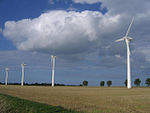Winterton Dunes
Coastal features of NorfolkDunes of EnglandNature Conservation Review sitesNorfolk geography stubsSites of Special Scientific Interest in Norfolk

Winterton Dunes is an extensive dune system on the east coast of Norfolk, England, which has been designated as a National Nature Reserve of 109 ha. Winterton Dunes is within the Norfolk Coast AONB. The site is unusual in that it shows greater ecological similarities to the dune systems of the Baltic - which support acidic plant communities - rather than the dunes on the North Norfolk Coast - where the sand is calcareous. The site supports well developed areas of dune heath, wet 'slacks' between dunes and dune grassland which grades into grazing marsh and birch woodland.
Excerpt from the Wikipedia article Winterton Dunes (License: CC BY-SA 3.0, Authors, Images).Winterton Dunes
Vichyplatz,
Geographical coordinates (GPS) Address Nearby Places Show on map
Geographical coordinates (GPS)
| Latitude | Longitude |
|---|---|
| N 52.7266 ° | E 1.6873 ° |
Address
Vichyplatz 1
83646
Bayern, Deutschland
Open on Google Maps









